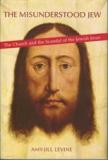Preachers, Teachers Take Note
In the more than 40 years since Vatican II, the short document on the relationship of the Catholic Church to other religions (Nostra Aetate) has emerged as especially important. Its section on the Jewish people suggests that mutual understanding and appreciation can best be furthered by biblical and theological inquiry and friendly discussions.
Written by a well-known Jewish New Testament scholar, The Misunderstood Jew illustrates the value of Jews and Christians studying Scripture together as a way of discovering what we share and how we come to define ourselves over and against another. The significance of this volume lies in its call for Christians—especially biblical scholars, preachers and theologians—to listen carefully to how a competent Jewish scholar reads the New Testament and evaluates its scholarly and popular interpretations.
Amy-Jill Levine has earned a respectful hearing. She worships in an Orthodox Jewish synagogue, obtained a doctoral degree in New Testament from Duke University, teaches at Vanderbilt Divinity School and is a faithful and very active member of the Catholic Biblical Association. She describes her attraction to and fascination with Catholicism during her childhood. But while admiring much of Jesus’ message, she does not worship the messenger.
Levine first shows the need for understanding Jesus in his first-century Jewish context. She contends that Jesus dressed like a Jew, prayed like a Jew, lived and taught like a Jew, argued with other Jews and died like other Jews on a Roman cross. She observes that Jesus does not have to be unique in order to be profound or meaningful. The question then arises whether other Jews, like Peter and Paul, really understood Jesus. She suggests that while the early Jewish Christians may have preserved Jesus’ message, the complex development of the increasingly Gentile church led rapidly to its separation from Judaism.
The most critical chapters of this book argue that New Testament scholars, preachers and liberation theologians have misunderstood the Jewish Jesus and propagated their misperceptions to the general public. Levine criticizes biblical scholars for constructing questionable historical scenarios as a way of disguising the anti-Judaism of the New Testament writers. She takes preachers to task for stereotyping Jews and Judaism as imposing burdensome laws, militaristic messianism, misogyny, obsession with ritual purity and so on. She chastises liberation theologians for using these anti-Jewish stereotypes as props with which to develop their positive message about Jesus and Christianity.
The author closes with reflections on the differences between Jews and Christians today—different canons, vocabularies, understandings and practices. Also included is a very helpful list of practical suggestions from “A to Z” about how the church and the synagogue today might relate more positively and constructively.
The book is based on lectures delivered in the United States and elsewhere. I can attest that Levine is an engaging and stimulating public speaker. The chapters on Jesus and the early church are generally objective, though the treatment of Paul’s Letter to the Galatians borders on parody. In print, however, the tone of the three “critical” chapters is often “debating points” style, and the humorous asides sometimes come across as verging on sarcasm. The link made between serious biblical scholars who propose translating the Greek word Ioudaios as “Judean” rather than “Jew” and the neo-Nazi attempts to deny the Jewishness of Jesus is a particularly unfortunate example. The harshness is ameliorated in the final two chapters where a more irenic tone prevails.
I found reading The Misunderstood Jew both challenging and humbling. While I agree with most of Levine’s critiques, a few of them hit home with me personally. For over 40 years my scholarly interests have been Second Temple Judaism and the New Testament, and I have always tried to interpret these wonderful texts in a way that I imagined was fair to and respectful of Judaism. Levine does not always agree. Her comments on various issues will at least make me pause and rethink some things I have taught and written over the years. That is the point of her book—to help serious Christians see that there is another perspective on Jesus and the New Testament, and to judge whether in our traditional and trendy interpretations of texts there has been the (even unconscious) dark shadow of anti-Judaism. As she says, “With friends like these we don’t need enemies.”
Most puzzling to me is Levine’s dismissal of the historical settings commonly invoked in New Testament studies today about the interpretation of 1 Thess 2:14-16 and about the origins of the Gospels of Matthew and John in conflicts within late-first century Judaism. She describes these as being “at best speculative.” But all historical studies are speculative to some degree, and Levine herself elsewhere insists on the liberating value of studying history. These historical settings have in my opinion proven themselves by illuminating otherwise obscure texts. For example, even if the so-called Council of Jamnia was nothing like Vatican II, something like its alleged effects must have triggered the expulsion of the Johannine Christians from the synagogue.
The Jesus who emerges from this book remains within first-century Judaism as Levine construes it. Her positive proposals and sharp critiques deserve the attention of Christian biblical scholars, preachers and theologians. Thus her book can contribute (perhaps somewhat painfully) to the mutual understanding and appreciation that Vatican II’s Nostra Aetate hoped to promote.
This article also appeared in print, under the headline “Preachers, Teachers Take Note,” in the December 18, 2006, issue.








